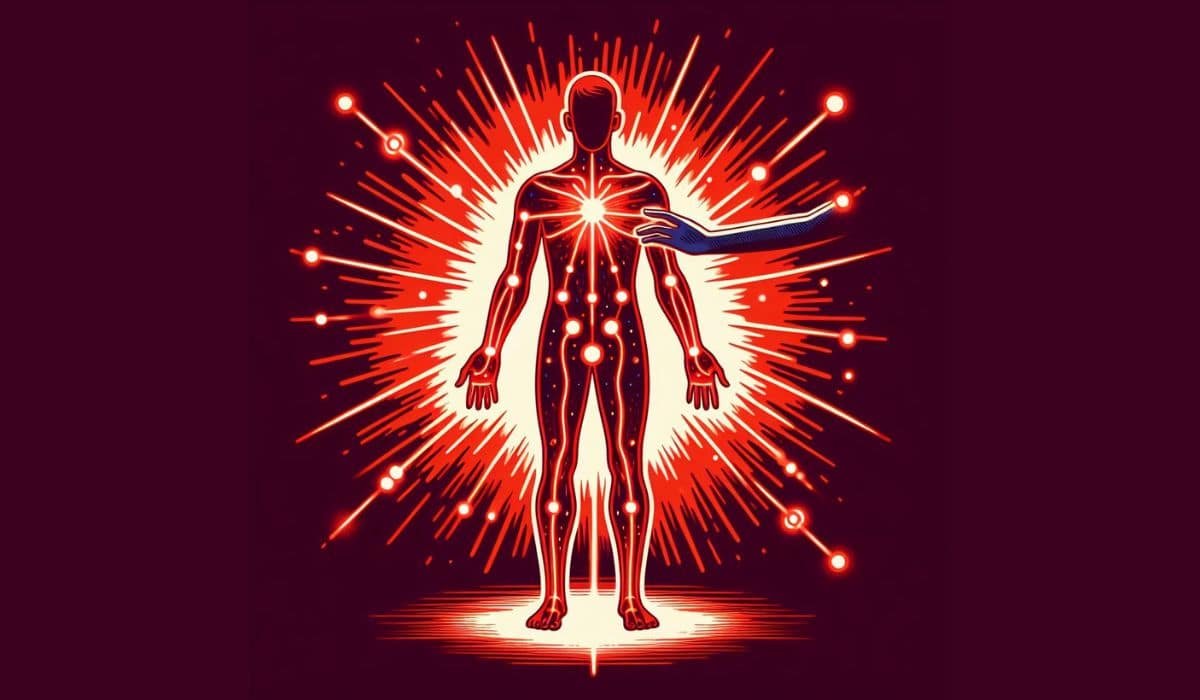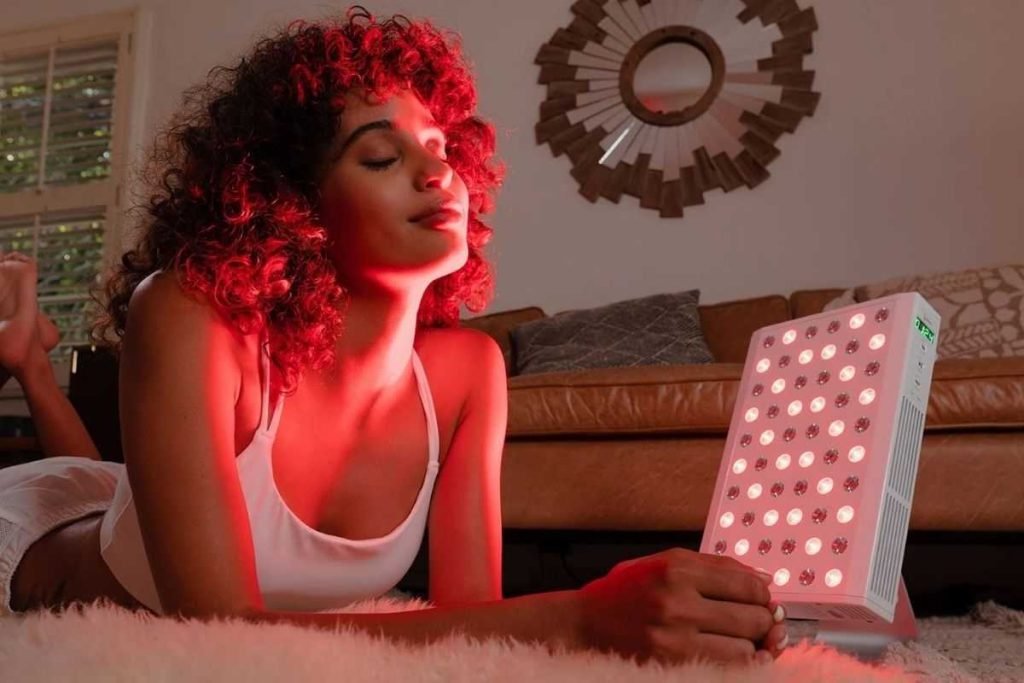Can Red Light Therapy Reduce Inflammation?

The short answer is that yes, Red Light Therapy (RLT) – which is also known as Low-Level Laser (Light) Therapy (LLLT) – can reduce inflammation.
In fact, there are numerous scientific studies – which I am about to address to – proving that RLT can reduce the inflammatory process, decrease the number of inflammatory cells, and have a role in modulating chronic inflammation.
In this article, I am going to list all the research around Red Light therapy and inflammation as well as giving a more details around each research.
Here’s a quick table with the research I’ve done. The numbers in brackets open in a new window and it will take you to the respective scientific study of each claim.
| Topic | Summary |
|---|---|
| Red Light Therapy and Inflammation | Red light therapy (RLT) can reduce inflammation by increasing cellular energy, stimulating cellular work, increasing blood circulation, reducing oxidative stress, and enhancing antioxidant defenses. |
| RLT for Rat Inflammation | A study found that red lasers with wavelengths 660 nm and 684 nm reduced swelling and inflammation in rat paws induced by carrageenan. [1] |
| RLT for Pain | Another study found that red LED light therapy effectively reduced acute pain and inflammation in rats by affecting the glutamatergic system and blocking pain signals. [2] |
| RLT for Oral and Dental Disorders | A review article analyzed studies on low-level light/laser therapy (LLLT) as a potential treatment for oral and dental issues, finding 130 positive outcomes and 23 inconclusive or negative results. [3] |
| RLT for COVID-19 | A study suggested that treating COVID-19 with photobiomodulation therapy may be effective by reducing inflammation and cytokines in just 48 hours. [4] |
| RLT for Acne | A study explored the use of low-level red LED light therapy as a potential treatment for acne, finding that it reduces inflammation and normalizes hyperkeratinization in the skin. [5] |
Red Light Laser Reduces Rat Inflammation
A study done on rats and published in the Journal of Photochemistry and Photobiology discovered that using red lasers with wavelengths 660 nm and 684 nm reduced swelling and inflammation in rat paws induced by carrageenan.
Carrageenan is a natural food ingredient derived from red seaweed. It is commonly used as a thickening, stabilizing, and gelling agent in various food products. Although the inflammatory effects of carrageenan in humans is still a topic of debate, some studies suggest that carrageenan may contribute to intestinal inflammation and digestive issues in certain individuals.
The laser-treated groups showed significantly less swelling and fewer inflammatory cells compared to the control group, indicating the potential anti-inflammatory effects of low-level laser therapy.
Red LED Therapy Reduces Pain
Another study done on rats, published in the same journal (Journal of Photochemistry and Photobiology), found that red LED light therapy effectively reduced acute pain and inflammation.
The study used different doses and durations of red LED exposure before experiments and observed a significant decrease in neurogenic and inflammatory pain induced by substances like formalin, acetic acid, cinnamaldehyde, capsaicin, menthol, and acidified saline.
The red LED light also played a role in the glutamatergic system and blocked pain triggered by different signals.
The glutamatergic system refers to the network of neurons in the brain that use the neurotransmitter glutamate to communicate with each other.
Additionally, the therapy showed antiedematogenic effects and reduced inflammatory cell migration.
Antiedematogenic refers to the ability to prevent or reduce edema, which is the accumulation of fluid in the body’s tissues
The results hint at how red LED therapy may relieve pain and reduce inflammation, but more research in animal studies is needed for a clearer understanding.

LLLT: A Promising Dental Therapy
In a review article, published in May 2014 in the journal Dental Materials, researchers explored the scientific literature on Low-Level Light/Laser Therapy (LLLT) as a potential treatment for oral and dental issues.
The review analyzed studies from 2010 to March 2013, revealing 130 positive outcomes, including pain relief and symptom improvement, and 23 inconclusive or negative results.
The data suggest that LLLT could be a reliable and safe approach for treating oral and dental disorders, especially where current solutions are lacking.
Infrared Light Mitigates COVID-19 Inflammation
Another study published in the journal Communicative & Integrative Biology, suggests that treating COVID-19 with photobiomodulation therapy may be effective.
The leading cause of COVID-19 mortality is respiratory distress due to an exaggerated immune response. As proved, current drug therapies (vaccines etc.) have limitations.
On the other hand infrared light exposure for just two 10-minute sessions daily significantly reduced inflammation-related pathways.
Infrared light quickly reduces inflammation and cytokines in just 48 hours, indicating it affects cellular mechanisms involving reactive oxygen species. The study suggests using infrared light clinically to help reduce COVID-19 mortality.
Cytokines are small signaling proteins that play a crucial role in immune responses and inflammation. High levels of cytokines are often associated with inflammation and disease.

Low Level Red Light For Acne
A study published in the journal Photomedicine and Laser Surgery explored the use of low-level red LED light therapy as a potential treatment for acne.
The study focused on lower doses of red light in an in vitro model mimicking acne conditions. Results show that red LED light, even at low doses, reduces inflammation and normalizes hyperkeratinization in the skin.
In vitro means “in glass” in Latin and it means that the experiment is done in test tubes or other containers instead of living organisms.
Hyperkeratinization is too much skin protein, causing issues like clogged pores in conditions such as acne.
The therapy shows promise in improving barrier function and may offer beneficial effects for individuals with acne by addressing key factors associated with the condition.
How does red light therapy fight inflammation?
Red Light Therapy (RLT) fights inflammation through a few key mechanisms:
- Cellular Energy Production: RLT works by acting on the mitochondria, the “power generators” of your cells. The mitochondria absorb the red light and produce more energy. This increased energy production allows cells to work more efficiently, such as repairing skin, boosting new cell growth, and enhancing skin rejuvenation.
- Stimulation of Cellular Work: Certain cells absorb light wavelengths and are stimulated to work. This stimulation can spur healing in skin and muscle tissue.
- Increased Blood Circulation: Red light therapy increases blood circulation to the tissues, which can help deliver nutrients and remove waste products, aiding in the healing process.
- Reduced Oxidative Stress: RLT reduces oxidative stress, which is a key factor in inflammation.
- Enhanced Antioxidant Defenses: RLT helps build the cell defense systems to increase resiliency.
These combined effects result in a reduction of inflammation at the cellular level.
Questions And Answers
Bottom Line
Red Light Therapy (RLT) is a promising treatment for various health conditions, especially those involving inflammation and pain. RLT works by stimulating cellular energy production, blood circulation, and antioxidant defenses, while reducing oxidative stress and inflammation.
Numerous scientific studies have shown the positive effects of RLT on rats, in vitro models, and humans.
RLT may offer a safe, effective, and non-invasive alternative to conventional therapies for oral and dental disorders, acne, COVID-19, and more.
More on Red Light Therapy
